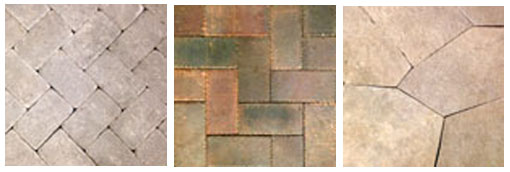During the winter months, a frequently asked question that we get is “What type of de-icer (also called ice melt) is okay to use on my walkway or driveway?”. This is not a question that we can answer with “This is the best product to use”.
This post talks about how de-icers work, things to consider when selecting a de-icer; what’s commonly used in the Chicagoland area, with their pros and cons; tips for applying a de-icer; paving material types, and additional links for more information.
How De-icers Work
When rock salt is applied to snow or ice, it creates brine (salt water). When the brine works its way into the cracks and pores of the material, it freezes and expands, causing damage.
De-icers can be used in three ways. The first is as a preventative, applied before snowfall to reduce snow accumulation. The second is as a snow melter, applied after the snow has been manually cleared to melt the remaining snow. The third is as an ice breaker, applied after ice has begun to build up, to break it down. De-icers will work their way into the ice and create a layer of brine between the pavement and the ice.
Pay close attention to the outside temperatures as some de-icers don’t work as well in extreme cold. Some de-icers react chemically to generate heat when in contact with snow or ice, allowing for it to work better on much colder days.
Things to Consider When Selecting a De-Icer
In selecting the right de-icer for your paving, it’s helpful to answer the following questions:
- Will children or the elderly need this area kept free of snow/ice?
- What type of material am I applying the de-icer on– poured concrete; natural stone, clay pavers, concrete pavers or asphalt?
- What is the outside temperature that the de-icer will need in order to work (i.e. above 15° F or 5° F)?
- Are there plantings or turf close to the area that de-icers will be applied?
- Will pets walk through the area that the de-icer will be applied?
Many de-icers are blends that contain any of the following:
Sodium Chloride (NaCl), commonly known as rock salt, is the least costly and is also one of the most commonly available products. Sodium chloride works when temperatures drop to 15° – 20° F. Sodium chloride can damage concrete, asphalt, brick stone metal, decks, and plants, and is unhealthy for pets. Advantages: Least costly. Disadvantages: Damages surfaces (minimal to moderate) and is somewhat dangerous to pets.
Potassium Chloride (KCl) is not sold in all stores, but is still commonly available and is typically slightly more expensive than sodium chloride. Potassium chloride works similarly to sodium chloride but is less toxic to plants and pets. Advantages: Safer for pets and more environmentally friendly (compared to sodium chloride). Disadvantages: Damages surfaces (minimal to moderate) and somewhat dangerous to pets (lethal to pets with kidney disease).
Calcium chloride (CaCl2) is available locally at many stores, and is typically moderately more expensive than sodium chloride. Calcium chloride works down to –20° F and is slightly less toxic than sodium chloride. One advantage to using calcium chloride is that it heats up, allowing it to penetrate into built-up ice and snow. Advantages: Quick, penetrates into ice, works in colder weather (compared to sodium chloride). Disadvantages: Damages surfaces (minimal to moderate).
There are other de-icers available, including Magnesium Chloride, Calcium Magnesium Acetate, Urea, as well as non-clumping kitty litter and sand. These options also have advantages and disadvantages.
Proper Application is Important
For large areas, we recommend using a mechanical spreader to ensure the correct amount of de-icer is applied. Read the label on the packaging to determine the proper application rate. Damage occurs when too much de-icer is applied. If spreading it by hand, wear gloves or use a cup. Wash your hands after handling any de-icer. In either case, if too much de-icer is applied, you can use a broom to disperse it. Make sure to clean your spreader, as the de-icer will corrode any exposed metal parts.
Paving Types and Recommended De-Icers
Not all types of paving material are equal when it comes to de-icers. The more porous the material, the more likely it will be damaged by a de-icer. High strength (PSI) and low porous material are other important factors that should be considered when applying de-icers. Holding up better doesn’t mean pavers are indestructible, so care should be taken to prevent overapplication. The following lists PSI of various materials and de-icer recommendations from manufacturers and a natural stone industry organization.
Clay pavers naturally have high PSI. Manufacturer Pine Hall Brick makes clay pavers with 12,000 psi average compressive strength. They recommend magnesium chloride as a de-icer for clay pavers, but advise not to use it on concrete.
Natural limestone and bluestone, with an average PSI of 5,000-7,000, are soft stones and are susceptible to damage from overuse of de-icers. The Natural Stone Institute recommends calcium chloride (CaCl2). It’s fast-acting, readily available, and works at very low temperatures– nearly eliminating the possibility of refreezing.
Concrete pavers have varying PSI depending on type, though some have been engineered with very high PSI and are able to hold up better to de-icers. For example, Unilock’s Brussels Block concrete pavers have a PSI of 8,000-12,500. They recommend rock salt (sodium chloride).
Poured concrete, has a lower average PSI of 2,500-5,000, and is very susceptible to de-icer damage during the first two years after it is installed. During this time you should not apply any de-icers; instead we recommend shoveling the snow/ice and spreading kitty litter or sand for traction.
Asphalt is not measured in PSI, but the Illinois Asphalt Pavement Association states that hot mix asphalt driveways are not impacted by certain chlorides contained in most de-icing agents, including sodium chloride, magnesium chloride or calcium chloride.
Additional Links for More Information:


